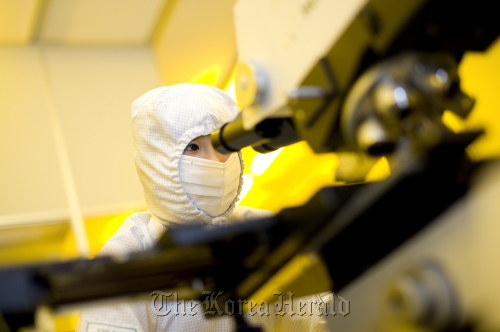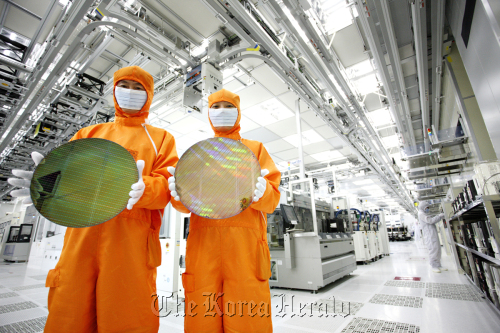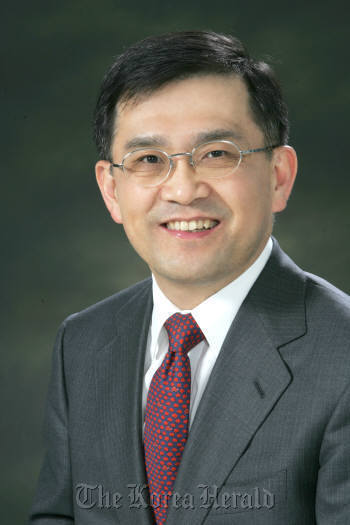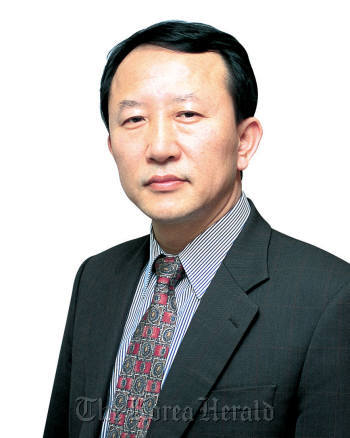 |
A Samsung Electronics employee works at its factory. (Samsung Electronics) |
Analysts give promising outlooks for Samsung Electronics, Hynix Semiconductor
The global business environment for Korea’s top two chip makers is showing signs of improving, causing analysts to paint a rosy prospect for their business.
The year of 2012 is projected to become a more exciting one than the last for the semiconductor industry, especially for Samsung Electronics and Hynix Semiconductor, since the prices of dynamic random access memory chips for PCs and mobiles are set to be stabilized with the increase in demand, industry sources said.
The semiconductor industry is largely divided into two categories, which are the memory ― DRAM and NAND Flash ― and the non-memory System LSI that includes central processing unit, mobile CPU, contact image sensor and digital signal processor.
The reactivation of factories in Thailand, which were hit by destructive flooding last year, will also offer a steady supply of hard disk drive storages by this month, enabling firms to meet the international PC demand.
 |
Workers are seen at the Hynix Semiconductor production line. (Hynix) |
Orders for the NAND Flash memory are projected to rise with the introduction of new gadgets like Apple’s iPad 3 and Samsung’s Galaxy S3 as well as the soaring popularity of smartphones in China.
“The country’s semiconductor industry will most likely enter its second turning point in 2012 as Samsung Electronics is excelling its performance in the non-memory System LSI business, Hynix is taking up a bigger portion in the NAND Flash memory sector and the DRAM prices are to stabilize,” said Lee Jae-yun, an analyst at Kiwoom Securities.
Shrinking competition
Industry sources say the Japanese and Taiwanese rivals of the two local firms are likely to play a shrinking role in the global market as they have previously planned to cut their productions earlier last year.
Japan’s Elpida, which has about a 12 percent share in the DRAM market, has reportedly cut production from early December of last year and it is likely to book about $1.2 billion in operating losses for the April-December period.
There were also rumors that the Japanese rival is seeking a tie-up with the U.S.-based Micron Technology and Taiwan’s Nanya Technology in a bid to finance its debts, but the report was denied by Nanya earlier this week. Elpida is scheduled to release its quarterly results on Thursday.
The sluggish performances of the chip makers come as the DRAM prices dropped sharply last year as the weakened economy worldwide drained demand. Many consumers also chose to make the switch to tablet PCs that use flash memory, a step away from personal computers that use DRAM chips.
Nanya also announced a 10 percent cut in production last September and another 10 to 20 percent decrease in November. In a related move, Taiwan’s Powerchip has sold its shares of Apacer Technology to finance about $100 billion.
“The PC DRAM sector is forecasted to begin to improve with the industrial followers curtailing their productions in the first quarter of this year,” said Nam Tae-hyun, an analyst at IBK Securities.
In the DRAM market, Samsung Electronics is a dominant player with a 45 percent share, followed by No. 2 Hynix with a 20 percent share. Micron and Elpida both had about 12 percent each and Nanya recorded 4 percent.
Market competitiveness
Along with the fact that the global top tier chip makers will face less competition this year, the demand for NAND Flash memory ― widely used in wireless devices such as smartphones and tablets ― will continue to be strong in 2012, according to analysts.
“Smartphones are expected to grow 47 percent year-on-year, rising to 623 million units, and the tablets are also projected to increase 76 percent year-on-year to top 93 million units,” said Kiwoom analyst Kim Sung-in.
He also added that smartphones drove a 67 percent year-on-year growth and tablets increased 220 percent over the same period.
This indicates that the demand for NAND Flash memory will highly surge, adding momentum to the global top two manufacturers ― Samsung and Hynix.
As exemplary cases, the chips of Amazon’s Kindle Fire and Apple’s iPhone 4S are built by Samsung and Hynix.
In a related effort, Samsung received the green light from the government to build a NAND Flash memory factory in China earlier last year.
The move was made to meet the rising demand of the Chinese market, which is adopting the smartphone at a fast pace.
Hynix and Intel, a well-known name and a top player in the global semiconductor industry, already have manufacturing plants in China.
“The smartphones as well as the Solid State Drive chips for the PCs will both officially lead growth for the NAND Flash market beginning this year,” said Song Jong-ho, an analyst at Daewoo Securities.
The SSD chips are mainly used in the new ultrabooks, a concept introduced by Intel. A number of PC makers, such as Samsung Electronics, LG Electronics, Acer, Dell, HP and Lenovo, have unveiled the new laptops that come with a sleek design at the electronics trade show in Las Vegas last month.
Kim of Kiwoom Securities added that Samsung bigger role in the non-memory System LSI ― which takes more than 80 percent of the semiconductor industry ― will become the engine for growth in 2012.
Considering that Samsung has grown about 50 percent year-on-year since 2010, that growth streak will continue this year and the total sales figure for 2012 is expected to reach $14.5 billion in 2012 and $19.4 billion in 2013, rising as the international No. 2 player in non-memory after Intel, he said.
“There is a limit to only doing memory business so we plan to focus on the non-memory sector and strategically nurture it as our future growth engine,” said a Samsung official.
Strong leadership
Another point to watch in terms of growth is that the two companies are currently backed by strong leaders ― Hynix’s chief executive Kwon Oh-chul and Samsung’s vice chairman Kwon Oh-hyun.
Hynix’s Kwon has been confirmed to retain his chief executive position in a recent board meeting.
 |
Samsung’s Kwon Oh-hyun |
 |
Hynix’s Kwon Oh-chul |
The decision follows SK Telecom’s takeover of Hynix, which is planned to be completed by this month.
Industry sources say the granting of Kwon Oh-chul’s stay indicates that SK chairman Chey Tae-won has acknowledged the Hynix CEO’s expertise in the field.
Kwon Oh-chul also showed confidence by visiting the U.S. in January in alignment with the Consumer Electronics Show in Las Vegas to discuss business with its top U.S. partners, which includes major PC makers.
On the other hand, Hynix’s rival Samsung Electronics is headed by Kwon Oh-hyun, who has been acting as the firm’s device solutions chief since July last year.
In December, Samsung showed its willingness to give more power to the device solutions unit ― responsible for subparts such as semiconductor chip ― promoting Kwon Oh-hyun as vice chairman, creating a “two-top system” with vice chairman Choi Gee-sung.
Under Kwon Oh-hyun’s leadership, Samsung has decided to inject 15 trillion won in the semiconductor sector this year, up from 13 trillion won in 2011. The breakdown of the investment is yet to be unveiled.
As part of Samsung’s investments, the device solutions chief has said the company will make aggressive investments in the Chinese market considering that the time has come to go ahead with a more forward-looking policy in China.
By Cho Ji-hyun (
sharon@heraldcorp.com)











![[Herald Interview] How Gopizza got big in India](http://res.heraldm.com/phpwas/restmb_idxmake.php?idx=644&simg=/content/image/2024/11/20/20241120050057_0.jpg)